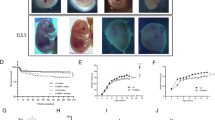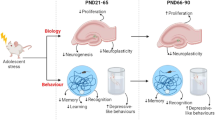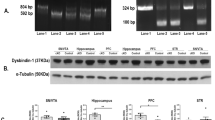Abstract
Hippocampal function has been implicated in mood and anxiety disorders, as well as in the response to antidepressant (AD) treatment. However, the significance of new neurons in the therapeutic mechanism of ADs remains unclear. In this study, the proliferation of new neurons was inhibited through conditional deletion of ataxia telangeictasia-mutated and rad-3 related (ATR), a cell cycle checkpoint kinase, and cellular and behavioral outcomes following AD exposure were evaluated. ATR was conditionally deleted by microinjecting a Cre recombinase-expressing virus into the hippocampus of floxed-ATR mice. Behavioral assessment in multiple rodent models of affective state revealed anxiolytic-like behavior in the elevated zero maze, marble burying test, and novelty-induced hypophagia (NIH) test. The efficacy of chronic desipramine (DMI) treatment was evaluated in the NIH test, as this paradigm is thought to be sensitive to increases in neurogenesis by chronic AD exposure. Chronic exposure to DMI reduced hyponeophagia in the NIH test in control mice, whereas DMI had no behavioral effect in ATR-deleted mice. Although DMI did not alter cell proliferation in either group, it did produce a robust increase in dendritic spine density in control mice, indicative of enhanced neuronal plasticity. This effect of DMI on spine density was severely attenuated following ATR deletion. These findings demonstrate that reductions in basal neurogenesis produce an anxiolytic phenotype and reduce AD efficacy in behaviors requiring chronic exposure. Furthermore, attenuated capacity for synaptic remodeling may underlie these behaviors. ATR deletion may serve as a valuable model to study the various proposed roles of newborn neurons in the hippocampus.
Similar content being viewed by others
Log in or create a free account to read this content
Gain free access to this article, as well as selected content from this journal and more on nature.com
or
References
Balu DT, Hodes GE, Anderson BT, Lucki I (2009). Enhanced sensitivity of the MRL/MpJ mouse to the neuroplastic and behavioral effects of chronic antidepressant treatments. Neuropsychopharmacology 34: 1764–1773.
Balu DT, Lucki I (2009). Adult hippocampal neurogenesis: regulation, functional implications, and contribution to disease pathology. Neurosci Biobehav Rev 33: 232–252.
Bergami M, Berninger B, Canossa M (2009). Conditional deletion of TrkB alters adult hippocampal neurogenesis and anxiety-related behavior. Commun Integr Biol 2: 14–16.
Bessa JM, Ferreira D, Melo I, Marques F, Cerqueira JJ, Palha JA et al (2009). The mood-improving actions of antidepressants do not depend on neurogenesis but are associated with neuronal remodeling. Mol Psychiatry 14: 764–773, 739.
Bondolfi L, Ermini F, Long JM, Ingram DK, Jucker M (2004). Impact of age and caloric restriction on neurogenesis in the dentate gyrus of C57BL/6 mice. Neurobiol Aging 25: 333–340.
Brown EJ, Baltimore D (2000). ATR disruption leads to chromosomal fragmentation and early embryonic lethality. Genes Dev 14: 397–402.
Brown EJ, Baltimore D (2003). Essential and dispensable roles of ATR in cell cycle arrest and genome maintenance. Genes Dev 17: 615–628.
Brown JP, Couillard-Despres S, Cooper-Kuhn CM, Winkler J, Aigner L, Kuhn HG (2003). Transient expression of doublecortin during adult neurogenesis. J Comp Neurol 467: 1–10.
Calabrese F, Molteni R, Racagni G, Riva MA (2009). Neuronal plasticity: a link between stress and mood disorders. Psychoneuroendocrinology 34 (Suppl 1): S208–S216.
Conboy L, Varea E, Castro JE, Sakouhi-Ouertatani H, Calandra T, Lashuel HA et al (2010). Macrophage migration inhibitory factor is critically involved in basal and fluoxetine-stimulated adult hippocampal cell proliferation and in anxiety, depression, and memory-related behaviors. Mol Psychiatry (e-pub ahead of print 23 February 2010).
Couillard-Despres S, Wuertinger C, Kandasamy M, Caioni M, Stadler K, Aigner R et al (2009). Ageing abolishes the effects of fluoxetine on neurogenesis. Mol Psychiatry 14: 856–864.
David DJ, Klemenhagen KC, Holick KA, Saxe MD, Mendez I, Santarelli L et al (2007). Efficacy of the MCHR1 antagonist N-[3-(1-{[4-(3,4-difluorophenoxy)phenyl]methyl}(4-piperidyl))-4-methylphen yl]-2-methylpropanamide (SNAP 94847) in mouse models of anxiety and depression following acute and chronic administration is independent of hippocampal neurogenesis. J Pharmacol Exp Ther 321: 237–248.
David DJ, Samuels BA, Rainer Q, Wang JW, Marsteller D, Mendez I et al (2009). Neurogenesis-dependent and -independent effects of fluoxetine in an animal model of anxiety/depression. Neuron 62: 479–493.
Dulawa SC, Hen R (2005). Recent advances in animal models of chronic antidepressant effects: the novelty-induced hypophagia test. Neurosci Biobehav Rev 29: 771–783.
Duman CH, Schlesinger L, Russell DS, Duman RS (2008). Voluntary exercise produces antidepressant and anxiolytic behavioral effects in mice. Brain Res 1199: 148–158.
Elizalde N, Garcia-Garcia AL, Totterdell S, Gendive N, Venzala E, Ramirez MJ et al (2010). Sustained stress-induced changes in mice as a model for chronic depression. Psychopharmacology (Berl) 210: 393–406.
Fuss J, Ben Abdallah NM, Hensley FW, Weber KJ, Hellweg R, Gass P (2010a). Deletion of running-induced hippocampal neurogenesis by irradiation prevents development of an anxious phenotype in mice. PLoS One 5 (9): e12769.
Fuss J, Ben Abdallah NM, Vogt MA, Touma C, Pacifici PG, Palme R et al (2010b). Voluntary exercise induces anxiety-like behavior in adult C57BL/6J mice correlating with hippocampal neurogenesis. Hippocampus 20: 364–376.
Gundersen BB, Blendy JA (2009). Effects of the histone deacetylase inhibitor sodium butyrate in models of depression and anxiety. Neuropharmacology 57: 67–74.
Gur TL, Conti AC, Holden J, Bechtholt AJ, Hill TE, Lucki I et al (2007). cAMP response element-binding protein deficiency allows for increased neurogenesis and a rapid onset of antidepressant response. J Neurosci 27: 7860–7868.
Hajszan T, MacLusky NJ, Leranth C (2005). Short-term treatment with the antidepressant fluoxetine triggers pyramidal dendritic spine synapse formation in rat hippocampus. Eur J Neurosci 21: 1299–1303.
Holick KA, Lee DC, Hen R, Dulawa SC (2008). Behavioral effects of chronic fluoxetine in BALB/cJ mice do not require adult hippocampal neurogenesis or the serotonin 1A receptor. Neuropsychopharmacology 33: 406–417.
Huang GJ, Bannerman D, Flint J (2008). Chronic fluoxetine treatment alters behavior, but not adult hippocampal neurogenesis, in BALB/cJ mice. Mol Psychiatry 13: 119–121.
Jacobs BL, van Praag H, Gage FH (2000). Adult brain neurogenesis and psychiatry: a novel theory of depression. Mol Psychiatry 5: 262–269.
Jessberger S, Kempermann G (2003). Adult-born hippocampal neurons mature into activity-dependent responsiveness. Eur J Neurosci 18: 2707–2712.
Lacefield CO, Itskov V, Reardon T, Hen R, Gordon JA (2010). Effects of adult-generated granule cells on coordinated network activity in the dentate gyrus. Hippocampus (e-pub ahead of print 29 September 2010, doi:10.1002/hipo.20860).
Law AJ, Weickert CS, Hyde TM, Kleinman JE, Harrison PJ (2004). Reduced spinophilin but not microtubule-associated protein 2 expression in the hippocampal formation in schizophrenia and mood disorders: molecular evidence for a pathology of dendritic spines. Am J Psychiatry 161: 1848–1855.
Lenze EJ, Sheffrin M, Driscoll HC, Mulsant BH, Pollock BG, Dew MA et al (2008). Incomplete response in late-life depression: getting to remission. Dialogues Clin Neurosci 10: 419–430.
Malberg JE, Duman RS (2003). Cell proliferation in adult hippocampus is decreased by inescapable stress: reversal by fluoxetine treatment. Neuropsychopharmacology 28: 1562–1571.
Malberg JE, Eisch AJ, Nestler EJ, Duman RS (2000). Chronic antidepressant treatment increases neurogenesis in adult rat hippocampus. J Neurosci 20: 9104–9110.
Marchetti C, Tafi E, Middei S, Rubinacci MA, Restivo L, Ammassari-Teule M et al (2010). Synaptic adaptations of CA1 pyramidal neurons induced by a highly effective combinational antidepressant therapy. Biol Psychiatry 67: 146–154.
Merikangas KR, Zhang H, Avenevoli S, Acharyya S, Neuenschwander M, Angst J (2003). Longitudinal trajectories of depression and anxiety in a prospective community study: the Zurich Cohort Study. Arch Gen Psychiatry 60: 993–1000.
Mizumatsu S, Monje ML, Morhardt DR, Rola R, Palmer TD, Fike JR (2003). Extreme sensitivity of adult neurogenesis to low doses of X-irradiation. Cancer Res 63: 4021–4027.
Moser MB, Trommald M, Andersen P (1994). An increase in dendritic spine density on hippocampal CA1 pyramidal cells following spatial learning in adult rats suggests the formation of new synapses. Proc Natl Acad Sci USA 91: 12673–12675.
Murray F, Smith DW, Hutson PH (2008). Chronic low dose corticosterone exposure decreased hippocampal cell proliferation, volume and induced anxiety and depression like behaviours in mice. Eur J Pharmacol 583: 115–127.
Navailles S, Hof PR, Schmauss C (2008). Antidepressant drug-induced stimulation of mouse hippocampal neurogenesis is age-dependent and altered by early life stress. J Comp Neurol 509: 372–381.
Norrholm SD, Ouimet CC (2001). Altered dendritic spine density in animal models of depression and in response to antidepressant treatment. Synapse 42: 151–163.
O’Leary OF, Wu X, Castren E (2009). Chronic fluoxetine treatment increases expression of synaptic proteins in the hippocampus of the ovariectomized rat: role of BDNF signalling. Psychoneuroendocrinology 34: 367–381.
Papp M, Willner P, Muscat R (1991). An animal model of anhedonia: attenuation of sucrose consumption and place preference conditioning by chronic unpredictable mild stress. Psychopharmacology (Berl) 104: 255–259.
Petersen A, Wortwein G, Gruber SH, El-Khoury A, Mathe AA (2009). Nortriptyline mediates behavioral effects without affecting hippocampal cytogenesis in a genetic rat depression model. Neurosci Lett 451: 148–151.
Revest JM, Dupret D, Koehl M, Funk-Reiter C, Grosjean N, Piazza PV et al (2009). Adult hippocampal neurogenesis is involved in anxiety-related behaviors. Mol Psychiatry 14: 959–967.
Ruzankina Y, Pinzon-Guzman C, Asare A, Ong T, Pontano L, Cotsarelis G et al (2007). Deletion of the developmentally essential gene ATR in adult mice leads to age-related phenotypes and stem cell loss. Cell Stem Cell 1: 113–126.
Ruzankina Y, Schoppy DW, Asare A, Clark CE, Vonderheide RH, Brown EJ (2009). Tissue regenerative delays and synthetic lethality in adult mice after combined deletion of Atr and Trp53. Nat Genet 41: 1144–1149.
Sahay A, Hen R (2007). Adult hippocampal neurogenesis in depression. Nat Neurosci 10: 1110–1115.
Salam JN, Fox JH, Detroy EM, Guignon MH, Wohl DF, Falls WA (2009). Voluntary exercise in C57 mice is anxiolytic across several measures of anxiety. Behav Brain Res 197: 31–40.
Santarelli L, Saxe M, Gross C, Surget A, Battaglia F, Dulawa S et al (2003). Requirement of hippocampal neurogenesis for the behavioral effects of antidepressants. Science 301: 805–809.
Saxe MD, Battaglia F, Wang JW, Malleret G, David DJ, Monckton JE et al (2006). Ablation of hippocampal neurogenesis impairs contextual fear conditioning and synaptic plasticity in the dentate gyrus. Proc Natl Acad Sci USA 103: 17501–17506.
Schmidt-Hieber C, Jonas P, Bischofberger J (2004). Enhanced synaptic plasticity in newly generated granule cells of the adult hippocampus. Nature 429: 184–187.
Schoevers RA, Van HL, Koppelmans V, Kool S, Dekker JJ (2008). Managing the patient with co-morbid depression and an anxiety disorder. Drugs 68: 1621–1634.
Scobie KN, Hall BJ, Wilke SA, Klemenhagen KC, Fujii-Kuriyama Y, Ghosh A et al (2009). Kruppel-like factor 9 is necessary for late-phase neuronal maturation in the developing dentate gyrus and during adult hippocampal neurogenesis. J Neurosci 29: 9875–9887.
Stranahan AM, Lee K, Martin B, Maudsley S, Golden E, Cutler RG et al (2009). Voluntary exercise and caloric restriction enhance hippocampal dendritic spine density and BDNF levels in diabetic mice. Hippocampus 19: 951–961.
Tada E, Parent JM, Lowenstein DH, Fike JR (2000). X-irradiation causes a prolonged reduction in cell proliferation in the dentate gyrus of adult rats. Neuroscience 99: 33–41.
Turner JR, Castellano LM, Blendy JA (2010). Nicotinic partial agonists varenicline and sazetidine-A have differential effects on affective behavior. J Pharmacol Exp Ther 334: 665–672.
von Bohlen Und Halbach O (2009). Structure and function of dendritic spines within the hippocampus. Ann Anat 191: 518–531.
Wang JW, David DJ, Monckton JE, Battaglia F, Hen R (2008). Chronic fluoxetine stimulates maturation and synaptic plasticity of adult-born hippocampal granule cells. J Neurosci 28: 1374–1384.
West MJ, Slomianka L, Gundersen HJ (1991). Unbiased stereological estimation of the total number of neurons in thesubdivisions of the rat hippocampus using the optical fractionator. Anat Rec 231: 482–497.
Zhu SW, Codita A, Bogdanovic N, Hjerling-Leffler J, Ernfors P, Winblad B et al (2009). Influence of environmental manipulation on exploratory behaviour in male BDNF knockout mice. Behav Brain Res 197: 339–346.
Acknowledgements
This research was supported by NIH Grant DA-011649 and CA-143187. JL Onksen was supported by a pre-doctoral NRSA (MH-087103).
Author information
Authors and Affiliations
Corresponding author
Ethics declarations
Competing interests
The authors declare no conflict of interest.
Additional information
Supplementary Information accompanies the paper on the Neuropsychopharmacology website
Supplementary information
Rights and permissions
About this article
Cite this article
Onksen, J., Brown, E. & Blendy, J. Selective Deletion of a Cell Cycle Checkpoint Kinase (ATR) Reduces Neurogenesis and Alters Responses in Rodent Models of Behavioral Affect. Neuropsychopharmacol 36, 960–969 (2011). https://doi.org/10.1038/npp.2010.234
Received:
Revised:
Accepted:
Published:
Issue date:
DOI: https://doi.org/10.1038/npp.2010.234
Keywords
This article is cited by
-
Hippocampal neurogenesis: a biomarker for depression or antidepressant effects? Methodological considerations and perspectives for future research
Cell and Tissue Research (2013)
-
Voluntary wheel running in mice increases the rate of neurogenesis without affecting anxiety-related behaviour in single tests
BMC Neuroscience (2012)
-
ATR maintains select progenitors during nervous system development
The EMBO Journal (2012)



